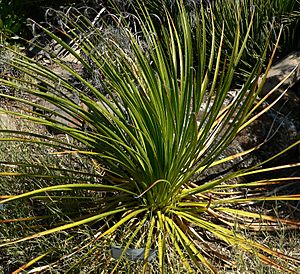Green sotol facts for kids
Quick facts for kids Green sotol |
|
|---|---|
 |
|
| Conservation status | |
| Scientific classification | |
| Synonyms | |
|
Dasylirion leiophyllum is a type of flowering plant. It belongs to the asparagus family. People often call it green sotol, smooth-leaf sotol, or smooth sotol. This plant grows naturally in North America. You can find it in Chihuahua and Coahuila in Mexico. It also grows in New Mexico and western Texas in the United States.
Contents
What Does Smooth Sotol Look Like?
This plant is a succulent shrub. This means it has thick parts that store water. It can grow a trunk up to one meter (about 3 feet) long. The trunk can stand straight up or lean over.
Its leaves are shiny and bright green. They are long and narrow, like blades. Each leaf can be up to 80 centimeters (about 31 inches) long and 2.5 centimeters (about 1 inch) wide. The edges of the leaves have small, sharp prickles. Older plants might have a layer of dead leaves around their trunk. This layer comes from leaves that died in past seasons.
Flowers and Reproduction
The flowers of the smooth sotol grow on a tall stalk. This stalk can reach five meters (about 16 feet) high. The part with the flowers is about 30 centimeters (about 12 inches) long.
This plant is dioecious. This means that male flowers and female flowers grow on separate plants. So, one plant will have only male parts, and another plant will have only female parts. The flowers are very tiny, about 2 millimeters long. They are usually whitish or greenish.
After flowering, the female plants produce fruit. The fruit is a small, three-winged capsule. It is less than one centimeter long. These plants can make new plants in two ways. They can grow from seeds. They can also sprout new plants from buds at the base of their leaves. This is called vegetative reproduction.
Where Smooth Sotol Grows
This plant is native to the Chihuahuan Desert. It is a very common plant in many areas there. Often, it grows alongside other plants like lechuguilla and walnut trees.
You can find smooth sotol in woodlands and desert grasslands. It often grows on calcareous ground. This means the soil has a lot of calcium carbonate, like limestone. It prefers dry areas. Other plants that might grow nearby include prickly pear cactus, yucca, nolina, Pinchot juniper, wavyleaf oak, skeleton goldeye, and different types of grasses like curlyleaf muhly, grama grasses, threeawns, and slim tridens.
Fire and the Smooth Sotol
Sometimes, a mature smooth sotol plant can catch fire. This can happen if lightning strikes it. Once it starts burning, it can burn for many hours. If the burning top of the plant falls off and rolls down a hill, it can spread fire to other parts of the habitat. Even after a fire, the plant can sometimes grow back. It does this by sprouting new shoots from the buds at the base of its leaves.
Uses of Smooth Sotol
Dasylirion leiophyllum is one of several plants in its genus used to make a Mexican drink called mezcal. Even though it's used for mezcal, it's important to know that sotol is not an Agave plant. Agave is another type of plant often used for similar drinks.
See also
 In Spanish: Dasylirion leiophyllum para niños
In Spanish: Dasylirion leiophyllum para niños


